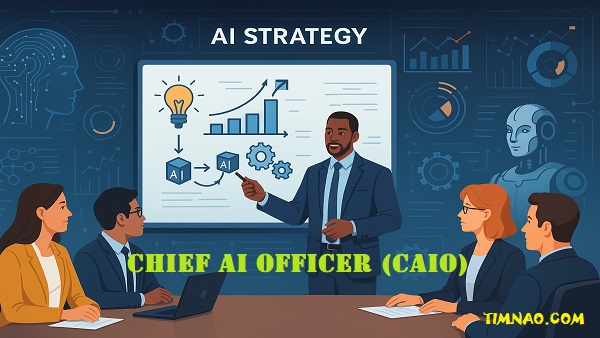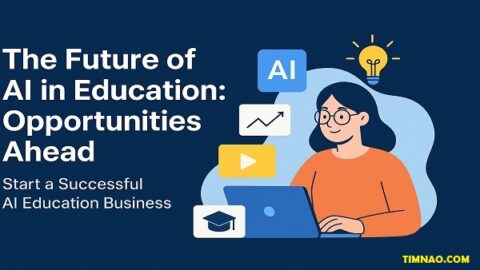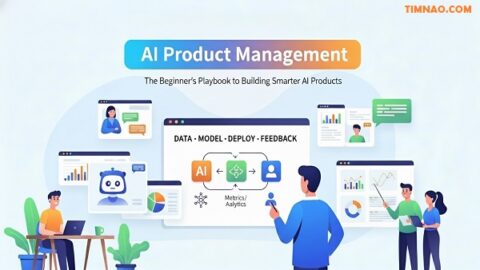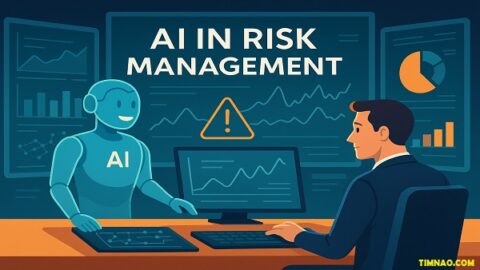Unlock Your Business’s Future: 16 Essential Insights from the Chief AI Officer’s Playbook for 2025
In today’s rapidly evolving technological landscape, Artificial Intelligence (AI) has transcended its status as a futuristic buzzword to become a fundamental driver of business transformation and competitive advantage. As organizations globally race to harness the power of AI, a new, critical leadership role has emerged: the Chief AI Officer (CAIO). The Chief AI Officer is no longer a luxury for tech giants but a strategic imperative for any company serious about navigating the complexities and seizing the opportunities of the AI era. This comprehensive guide will illuminate the multifaceted world of the Chief AI Officer, offering actionable insights and strategies to help your business not just survive, but thrive.
If you’re wondering how a Chief AI Officer can future-proof your operations, drive innovation, and ensure ethical AI adoption, you’re in the right place. We’ll delve into the core responsibilities, strategic frameworks, team-building essentials, and the critical aspects of governance and ethics that define this pivotal role. Prepare to unlock the playbook that leading Chief AI Officers are using to reshape industries in 2025 and beyond.
Table of Contents
- The Indispensable Innovator: Why Every Forward-Thinking Company Needs a Chief AI Officer
- The AI Maestro: Core Responsibilities and Impact of Today’s Chief AI Officer
- Architecting Tomorrow: Crafting a Winning AI Strategy for Unprecedented Enterprise Growth
- Building the Vanguard: Assembling and Nurturing High-Performing AI Teams
- Data as Destiny: Fueling Your AI Innovations with High-Octane Data Strategies
- The AI Voyage: Mastering AI Project Management for Seamless Execution
- Beyond the Algorithm: A Clear Guide to Deterministic, Probabilistic, and Generative AI
- The Autonomous Edge: Understanding AI Agents and the Dawn of Agentic Systems
- Blueprint for Brilliance: Designing Effective and Scalable AI Systems
- Teaching Machines to Think: The Art and Science of Training Powerful AI Models
- From Concept to Reality: Successfully Deploying Impactful AI Solutions Across Your Organization
- The Ethical Compass: Mastering AI Governance for Responsible and Trusted Innovation
- Cyber Sentinels: Essential Security Strategies for AI in an Interconnected World
- The Privacy Paradigm: Navigating Data Protection in the Age of Intelligent AI
- Charting the Course: AI Compliance and the Evolving Global Regulatory Maze
- Leading the AI Revolution: The Future of AI Leadership & Empowering Your CAIO
1. The Indispensable Innovator: Why Every Forward-Thinking Company Needs a Chief AI Officer 🚀
The conversation around AI has shifted dramatically. It’s no longer if AI will impact your business, but how profoundly and how soon. As AI capabilities explode, particularly with advancements in generative AI and AI agents, the need for dedicated, strategic leadership has become undeniable. A Chief AI Officer is this leader.
Many companies are moving beyond experimental AI uses to integrate AI into core operations for enhanced productivity and scale (Securiti). However, this integration comes with risks. The Chief AI Officer role is born out of the necessity to develop and implement a comprehensive AI strategy, ensure data privacy and security within AI solutions, and protect these systems against new, evolving threats. Without a CAIO, organizations risk fragmented AI efforts, missed opportunities, data breaches, ethical missteps, and ultimately, falling behind competitors who are strategically leveraging AI.
The demand for this role is surging. CEOs increasingly recognize AI as the technology that will most impact their industry (Gartner). The Chief AI Officer is the executive tasked with turning AI potential into tangible business value, aligning AI initiatives with overarching business goals, and fostering an AI-first culture. They are the bridge between technological possibility and strategic execution, ensuring that AI adoption is both ambitious and responsible.
2. The AI Maestro: Core Responsibilities and Impact of Today’s Chief AI Officer 🎯
The Chief AI Officer is a senior executive whose responsibilities are broad and deeply impactful, weaving through nearly every facet of a modern organization. Their primary mandate is to champion the company’s AI journey, transforming it into an AI-powered enterprise. Key responsibilities typically include:
- Developing and Overseeing AI Strategy: The CAIO crafts and spearheads the organization-wide AI vision and strategy, ensuring it aligns with business objectives. This includes identifying high-impact use cases, prioritizing initiatives, and defining a roadmap for AI adoption and maturation.
- Driving AI Innovation and Value Creation: A core function is to identify opportunities where AI can create new value, optimize processes, enhance customer experiences, and generate new revenue streams. They are constantly exploring emerging AI technologies and their potential business applications. This means looking at ROI (Return on Investment), ROE (Return on Employee experience), and ROF (Return on Future readiness) (Gartner).
- Establishing AI Governance and Ethical Frameworks: This is paramount. The CAIO is responsible for creating and enforcing policies for responsible AI development and deployment. This includes addressing data privacy, bias mitigation, transparency, accountability, and ensuring AI systems comply with evolving regulations. (Securiti, GDPR Local)
- Building and Leading AI Talent: The CAIO attracts, develops, and retains top AI talent, building high-performing, often cross-functional, AI teams. This involves fostering a culture of learning and experimentation.
- Championing Data Management and Infrastructure: Since data is the lifeblood of AI, the CAIO ensures the availability of high-quality data, robust data governance practices, and the necessary technological infrastructure (data pipelines, MLOps, compute resources) to support AI initiatives.
- Fostering AI Literacy and Adoption Across the Organization: The CAIO works to demystify AI and promote its adoption across different business units, ensuring that employees are equipped with the necessary skills and understanding to work with AI tools effectively.
- Managing AI Risks and Security: Identifying and mitigating risks associated with AI, including model bias, security vulnerabilities (like data poisoning or model hijacking), data breaches, and compliance failures. (HiddenLayer)
- Overseeing AI Partnerships and Vendor Management: Evaluating and managing relationships with AI technology vendors, research institutions, and other external partners.
- Measuring and Communicating AI Impact: Defining key performance indicators (KPIs) to measure the success and ROI of AI initiatives and communicating these effectively to stakeholders, including the board and executive team.
The impact of an effective Chief AI Officer is transformative. They can accelerate innovation, unlock significant efficiencies, enhance decision-making, create personalized customer experiences, and build sustainable competitive advantages.
3. Architecting Tomorrow: Crafting a Winning AI Strategy for Unprecedented Enterprise Growth 🗺️
A winning AI strategy is not just about adopting the latest technology; it’s about integrating AI into the very fabric of the business to achieve specific, measurable outcomes. The Chief AI Officer leads this strategic charge. Here’s a look at how to craft such a strategy:
- Align with Business Objectives: The AI strategy must be inextricably linked to the overall business strategy. What are the company’s core goals? Increase revenue? Improve customer satisfaction? Optimize operations? Reduce costs? Enhance innovation? The AI strategy should directly support these ambitions.
- Identify High-Impact Use Cases: Instead of a scattergun approach, focus on AI applications that offer the most significant potential value and align with strategic priorities. This involves collaborating with business units to understand their pain points and opportunities. The AI Use Case Insights Tool can be valuable here (Gartner).
- Assess Current AI Maturity: Understand the organization’s current AI capabilities, data readiness, talent pool, and infrastructure. Frameworks like Gartner’s AI Maturity Model (Awareness, Experimentation, Scaling, Optimization) can help benchmark progress and identify gaps (Facile Technolab).
- Develop a Data Strategy: As we’ll explore further, data is fundamental. The AI strategy must include a robust plan for data acquisition, management, governance, and security to ensure AI models are trained on high-quality, relevant, and ethically sourced data.
- Prioritize and Roadmap: Not all AI initiatives can be pursued simultaneously. Develop a phased roadmap with clear priorities, timelines, resource allocations, and milestones. Consider quick wins to build momentum and demonstrate value early on.
- Build vs. Buy vs. Partner: Decide whether to develop AI solutions in-house, purchase off-the-shelf tools, or collaborate with external partners. This decision depends on factors like internal expertise, speed to market, cost, and the strategic importance of the AI capability.
- Foster an AI-Ready Culture: An AI strategy is only as good as the organization’s ability to execute it. This requires fostering a culture that embraces data-driven decision-making, continuous learning, experimentation, and collaboration between technical and business teams.
- Establish Governance and Ethical Guardrails: From the outset, integrate ethical considerations and governance frameworks into the AI strategy. This includes addressing potential biases, ensuring transparency, and complying with regulations (Facile Technolab). The World Economic Forum and European Commission have popularized AI Governance Frameworks.
- Plan for Scalability and MLOps: Design AI systems and processes with scalability in mind. Implement Machine Learning Operations (MLOps) practices to streamline the development, deployment, and maintenance of AI models.
- Measure, Iterate, and Adapt: The AI landscape is dynamic. The AI strategy should be a living document, regularly reviewed and updated based on performance metrics, technological advancements, and changing business needs. Tracking process improvements, cost savings, and even how AI accelerates processes are key (Forbes).
Frameworks like the CRISP-DM (Cross-Industry Standard Process for Data Mining) for model development and the AI Canvas for designing AI-driven business models can provide structured approaches (Facile Technolab). The Chief AI Officer ensures this strategy is not just a document, but a dynamic blueprint for enterprise-wide transformation.
4. Building the Vanguard: Assembling and Nurturing High-Performing AI Teams 🤖🤝
The success of any AI strategy hinges on the talent behind it. The Chief AI Officer plays a crucial role in building and nurturing high-performing AI teams capable of turning vision into reality. This isn’t just about hiring data scientists; it’s about creating a synergistic ecosystem of diverse skills and fostering a culture of innovation.
Key Roles in an AI Team:
- Data Scientists: Experts in statistical modeling, machine learning algorithms, and data analysis. They develop and train AI models.
- Machine Learning Engineers: Focus on the practical application of ML models, including building scalable deployment pipelines, model monitoring, and MLOps.
- Data Engineers: Design, build, and maintain the data infrastructure and pipelines necessary to collect, store, process, and make data available for AI initiatives.
- AI Researchers/Scientists (for more advanced teams): Push the boundaries of AI, exploring new algorithms and approaches.
- AI Product Managers: Define the vision and roadmap for AI-powered products, understanding user needs and translating them into technical requirements.
- AI Ethicists/Governance Specialists: Ensure AI systems are developed and deployed responsibly, addressing ethical concerns and compliance.
- Domain Experts: Provide crucial business context and subject matter expertise to guide AI projects and ensure solutions are relevant and impactful.
- UX/UI Designers (for AI applications): Design intuitive interfaces for AI-powered tools and applications.
- AI/ML Ops Engineers: Focus on the lifecycle management, deployment, scaling, and monitoring of machine learning models in production.
Best Practices for Building and Managing AI Teams, informed by 2024/2025 insights:
- Foster Cross-Functional Collaboration: AI projects are rarely siloed. Encourage collaboration between AI specialists and business units. Diverse teams bring varied perspectives, enhancing creativity and problem-solving (Amazing Workplaces, Westford For Business).
- Cultivate a Culture of Continuous Learning and Experimentation: The AI field evolves rapidly. Encourage team members to continuously learn, upskill, and experiment with new tools and techniques. The World Economic Forum predicts 50% of employees will need reskilling by 2025 (Westford For Business).
- Promote Psychological Safety: Create an environment where1 team members feel safe to2 take risks, share ideas, and learn from failures without fear of retribution. Google’s Project Aristotle found this to be the most important factor in effective teams (Westford For Business).
- Embrace Diversity and Inclusion: Build diverse teams in terms of background, skills, and perspectives. This leads to more robust and less biased AI solutions.
- Provide the Right Tools and Infrastructure: Equip your team with the necessary hardware (e.g., GPUs), software, data platforms, and collaboration tools (like Slack, Microsoft Teams).
- Implement Agile Methodologies: Agile approaches, with their iterative cycles and focus on collaboration, are well-suited for AI projects, which often involve exploration and uncertainty. Agile leaders see 30-50% improvement in project success rates (Westford For Business).
- Establish Clear Roles and Responsibilities: While collaboration is key, clearly defined roles and responsibilities prevent confusion and ensure accountability.
- Empower AI Champions: Identify and empower individuals within teams who are passionate about AI and can drive adoption and share knowledge (Amazing Workplaces).
- Focus on Strategic Alignment: Ensure the AI team’s work is directly aligned with the overall business strategy and that they understand the impact of their contributions.
- Balance Automation with Human Expertise: Critical decisions should not be left solely to AI. Assign experienced employees to review and validate AI outputs (Amazing Workplaces).
- Invest in Training and Development: Microsoft, for instance, aims to provide AI skilling to 2 million people in India by 2025 (Amazing Workplaces). This highlights the global push for AI literacy.
The Chief AI Officer acts as the architect and conductor of this talent ecosystem, ensuring the team has the skills, resources, and environment to innovate and deliver exceptional results.
5. Data as Destiny: Fueling Your AI Innovations with High-Octane Data Strategies ⛽
In the realm of Artificial Intelligence, data isn’t just important; it’s the fundamental fuel. Without high-quality, relevant, and well-governed data, even the most sophisticated AI algorithms will falter. The Chief AI Officer champions a robust data strategy as a cornerstone of AI success.
Why Data is Critical for AI:
- Model Training: AI models, especially machine learning models, learn from data. The quality, quantity, and representativeness of this training data directly determine the model’s performance, accuracy, and fairness.
- Personalization: AI excels at delivering personalized experiences, but this requires granular data about customer preferences, behavior, and history.
- Predictive Analytics: Forecasting future trends, customer churn, or equipment failure relies on analyzing historical data patterns.
- Decision Making: AI-driven insights empower better, faster, and more data-informed decisions across the organization.
- Generative AI: Even generative AI models, while capable of creating novel content, are trained on vast datasets of existing text, images, or code. Retrieval-Augmented Generation (RAG) systems rely heavily on corporate data to ground their responses.
Key Components of an AI-Ready Data Strategy, with 2024/2025 trends:
- Data Acquisition and Sourcing: Identifying and accessing relevant data sources, both internal (CRM, ERP, IoT sensors) and external (public datasets, third-party data providers).
- Data Quality Management: Implementing processes to ensure data accuracy, completeness, consistency, and timeliness. This includes data cleaning, validation, and enrichment. “Garbage in, garbage out” is a critical mantra.
- Data Governance: This is increasingly crucial. Establishing clear policies, roles, and responsibilities for how data is collected, stored, accessed, used, and protected. This includes:
- Data Privacy: Complying with regulations like GDPR, CCPA, and others.
- Data Security: Protecting data from unauthorized access, breaches, and misuse.
- Data Lineage and Auditability: Tracking where data comes from and how it’s transformed.
- Bias Detection and Mitigation: Actively working to identify and address biases in datasets to prevent discriminatory AI outcomes.
- Systematic Data Ingestion for AI: Creating systematic ways for users to search corporate data stores, curate data, check for sensitive information, and move it to AI systems with audit reporting is a key prediction for 2025 (DBTA).
- Mature Unstructured Data Governance: With the rise of GenAI, governing unstructured data (documents, emails, images) is paramount to prevent leakage and ensure responsible use (DBTA).
- Data Infrastructure and Architecture: Building a scalable and flexible data infrastructure that can handle the volume, velocity, and variety of data required for AI. This includes data lakes, data warehouses, data lakehouses, and cloud-based platforms.
- Data Accessibility and Democratization: Making data accessible to relevant teams and AI models in a secure and controlled manner, while empowering employees with data literacy.
- Metadata Management: Effectively managing metadata (data about data) to improve data discovery, understanding, and usability. Data classification and metadata enrichment are key for AI data governance (DBTA).
- Synthetic Data Generation (Emerging Trend): In some cases, creating artificial data that mimics the statistical properties of real-world data can be used to train models when real data is scarce or sensitive.
- Real-time Data Processing: For many AI applications (e.g., fraud detection, real-time recommendations), the ability to process and analyze data in real-time is essential.
The Chief AI Officer must ensure that the organization treats data as a strategic asset. This involves fostering a data-driven culture, investing in data management technologies, and continuously refining data practices to support the ever-evolving needs of AI. The role of storage administrators is also evolving to embrace security and AI data governance, requiring them to work across functions (DBTA).
6. The AI Voyage: Mastering AI Project Management for Seamless Execution 🧭
AI projects are often complex, iterative, and carry a higher degree of uncertainty than traditional software development. Effective project management, tailored to the unique characteristics of AI, is therefore crucial for success. The Chief AI Officer ensures that robust AI project management methodologies are in place.
Unique Challenges in AI Project Management:
- Data Dependencies: AI projects are heavily reliant on data availability and quality. Data acquisition, cleaning, and preparation can be time-consuming and unpredictable.
- Exploratory Nature: Many AI projects involve research and experimentation. The optimal solution or algorithm may not be known at the outset.
- Measuring Success: Defining clear and measurable success metrics for AI projects can be challenging, especially for those focused on innovation or qualitative improvements.
- Ethical Considerations: AI projects often raise ethical questions that need to be addressed throughout the project lifecycle.
- Talent Scarcity: Finding and retaining skilled AI talent can be a bottleneck.
- Integration Complexity: Integrating AI solutions into existing business processes and IT systems can be complex.
- Model Drift and Maintenance: AI models can degrade in performance over time as the underlying data patterns change, requiring ongoing monitoring and retraining (MLOps).
Key Trends and Methodologies for AI Project Management in 2024/2025:
- Hybrid Project Management Approaches: Increasingly popular, combining the structured framework of traditional methods (like Waterfall for certain phases) with the flexibility and iteration of Agile principles (Epicflow). This adaptability is key for complex AI projects.
- Agile and Scrum for AI: Iterative development, frequent feedback loops, and adaptive planning make Agile methodologies well-suited for the experimental nature of many AI projects.
- CRISP-DM (Cross-Industry Standard Process for Data Mining): While a data mining framework, its phases (Business Understanding, Data Understanding, Data Preparation, Modeling, Evaluation, Deployment) provide a structured approach for AI/ML projects (Facile Technolab).
- MLOps (Machine Learning Operations): While not a project management methodology per se, MLOps practices are integral to managing the lifecycle of AI models, from development to deployment and ongoing monitoring. This ensures reproducibility, scalability, and reliability.
- Data-Driven Project Management: Leveraging data analytics within the project management process itself to monitor progress, identify bottlenecks, and make informed decisions (Epicflow).
- AI in Project Management: AI tools are increasingly being used to transform project management by:
- Predictive Analytics: Forecasting project timelines, costs, and potential bottlenecks (NCSU MEM, Epicflow).
- Intelligent Resource Allocation: Optimizing the assignment of team members to tasks based on skills and availability (NCSU MEM).
- Proactive Risk Management: Identifying potential risks early on (NCSU MEM).
- Automated Task Management: Streamlining routine tasks like reminders and status updates (NCSU MEM, Epicflow).
- Enhanced Communication: AI-powered assistants facilitating team collaboration (NCSU MEM).
- Focus on Value Delivery (Value Management Office): A growing trend is the emphasis on ensuring projects deliver tangible business value, often managed through a Value Management Office (VMO) (Epicflow).
- Strong Emphasis on Soft and Digital Skills: Project managers need skills in data science, innovative thinking, collaborative leadership, and knowledge of legal/regulatory compliance (Epicflow).
- Sustainability and ESG Practices: Integrating environmental, social, and governance considerations into project planning and execution (Epicflow).
The Chief AI Officer ensures that project teams are equipped with the right methodologies, tools, and skills to navigate the complexities of AI development. This includes fostering clear communication, managing stakeholder expectations, and ensuring that projects deliver real business value in an ethical and responsible manner.
7. Beyond the Algorithm: A Clear Guide to Deterministic, Probabilistic, and Generative AI 💡
Understanding the different types of AI is crucial for the Chief AI Officer to strategize effectively and communicate AI capabilities across the organization. While the lines can sometimes blur, AI systems can broadly be categorized based on how they operate and the types of problems they solve.
-
Deterministic AI:
- How it Works: These AI systems operate based on predefined rules and logic. Given the same input, they will always produce the same output. Think of them as complex flowcharts or decision trees.
- Characteristics: Highly predictable, transparent (the decision-making process is usually clear), reliable for tasks with well-defined rules.
- Examples:
- Rule-based expert systems (e.g., early medical diagnosis systems based on symptom checklists).
- Simple robotic process automation (RPA) bots that follow a script.
- Calculators or software that executes predefined algorithms.
- Use Cases: Tasks requiring consistency and adherence to strict rules, such as basic transaction processing, compliance checks based on fixed criteria, or simple automation.
-
Probabilistic AI (Often encompassing Machine Learning):
- How it Works: These systems learn from data to make predictions or decisions based on probabilities. They don’t follow explicit rules for every scenario but rather identify patterns and relationships in data to estimate the likelihood of different outcomes. Machine learning is a core component.
- Characteristics: Can handle uncertainty and complexity, adapt to new data (learn and improve over time), may not always be perfectly transparent (e.g., deep learning models can be “black boxes”).
- Examples:
- Spam filters (classifying emails as spam or not based on learned patterns).
- Recommendation engines (Amazon, Netflix) predicting what you might like.
- Image recognition systems (identifying objects in pictures).
- Fraud detection systems (flagging suspicious transactions).
- Natural Language Processing (NLP) for sentiment analysis.
- Use Cases: Prediction, classification, clustering, anomaly detection, personalization, and tasks where patterns need to be discerned from large datasets. This is where most modern AI applications currently reside.
-
Generative AI:
- How it Works: A subset of probabilistic AI (specifically deep learning) that focuses on creating new, original content rather than just predicting or classifying existing data. These models learn the underlying patterns and structures of the data they are trained on and then generate novel outputs that resemble the training data.
- Characteristics: Creative, can produce diverse outputs (text, images, audio, code, synthetic data), rapidly evolving, raises new ethical considerations (e.g., deepfakes, copyright).
- Examples:
- Large Language Models (LLMs) like OpenAI’s ChatGPT, Google’s Gemini, generating human-like text, translating languages, writing different kinds of creative content, and answering questions.
- Image generation models like DALL-E or Midjourney, creating images from text prompts.
- Code generation tools assisting developers.
- Music and voice synthesis.
- Use Cases: Content creation, chatbots and virtual assistants, software development, drug discovery, synthetic data generation for training other AIs, personalized marketing, and creative industries. McKinsey’s 2024 survey showed 65% of organizations regularly use GenAI, nearly double from the previous year (Esade). Salesforce notes that GenAI can save an average of 32.5 days per year for users (QSS Technosoft).
The Chief AI Officer must understand these distinctions to guide investments, set realistic expectations, and explain the capabilities and limitations of different AI approaches to stakeholders. Often, solutions involve a blend of these types. For example, a generative AI might create content, which is then evaluated by a probabilistic AI for quality or appropriateness. The key is to match the right AI approach to the specific business problem.
8. The Autonomous Edge: Understanding AI Agents and the Dawn of Agentic Systems 🦾
Beyond traditional AI models, the concept of AI agents and agentic systems is rapidly gaining prominence and is poised to redefine automation and decision-making in enterprises. A Chief AI Officer needs to be at the forefront of understanding and strategically leveraging this powerful evolution.
What are AI Agents?
An AI agent is a software entity that can perceive its environment (through sensors or data inputs), reason about its perceptions, make decisions, and take actions to achieve specific goals autonomously or with minimal human intervention. Unlike a simple model that makes a prediction, an agent can often plan, execute a sequence of actions, and learn from the outcomes.
Key Characteristics of AI Agents:
- Autonomy: They can operate independently without constant human guidance.
- Goal-Oriented: They are designed to achieve specific objectives.
- Perception: They can sense and interpret their environment.
- Reasoning/Decision-Making: They can process information and choose appropriate actions.
- Action: They can interact with their environment or other systems.
- Learning (often): Many advanced agents can learn from experience and improve their performance over time.
Agentic Systems (Multi-Agent Systems):
These involve multiple AI agents interacting with each other, often collaboratively or competitively, to solve complex problems that a single agent might struggle with. Think of a team of specialized robots working together on an assembly line or a group of software agents negotiating resource allocation.
Current Trends and Future Potential (2024-2025 and beyond):
- Rise of Agentic AI: If 2024 was about generative AI adoption, 2025 is predicted to be the year agentic AI becomes a business reality. These systems can think, plan, and act independently (Codewave). Gartner predicts that by 2025, 70% of organizations will operationalize AI designed for autonomy.
- Hyper-Autonomous Enterprise Systems: AI agents managing and optimizing entire business functions, such as real-time delivery route adjustments based on traffic and weather (Codewave). Deloitte projects 25% of enterprises using GenAI will deploy autonomous AI agents in 2025, doubling to 50% by 2027.
- Multi-Agent Collaboration Models: AI agents syncing across departments, like HR and finance agents collaborating on job offers, eliminating manual delays (Codewave).
- Self-Evolving AI Architectures: AI systems that can improve themselves by optimizing processes or user interfaces based on live feedback.
- Integration with Generative AI: Many AI agents leverage LLMs for their reasoning, planning, and communication capabilities. They can use APIs, web search, and databases to execute complex tasks (EAPJ).
- Vertical-Specific Agentic Solutions: Tailored AI agents for specific industries like healthcare (patient monitoring agents) or finance (fraud detection and algorithmic trading agents) (Codewave).
- Tools and Platforms: Emergence of platforms like Google Agentspace to transform enterprise productivity by tackling unstructured data and offering customizable AI agents (EAPJ).
Challenges and Considerations:
- Complexity: Designing, managing, and debugging agentic systems can be highly complex.
- Governance and Control: Ensuring autonomous agents operate within ethical boundaries and desired parameters is critical. “Governance-first AI deployment” is a key trend (Codewave).
- Security: Agentic systems can be new targets for attacks (e.g., prompt injections to exploit local models) (HiddenLayer).
- Explainability: Understanding why an agent made a particular decision can be challenging.
- Human Oversight: Critical decisions and high-stakes processes still demand human oversight to ensure accuracy, ethics, and accountability (EAPJ).
- Integration with Existing Systems: Seamlessly integrating AI agents into current enterprise architecture is a significant challenge (EAPJ).
The Chief AI Officer must strategically evaluate where AI agents can provide the most value, from automating complex workflows and enabling hyper-personalization to creating entirely new business models. This involves pilot projects, careful risk assessment, and building the necessary infrastructure and talent to support these advanced systems. The era of autonomous AI is dawning, and the CAIO will be pivotal in navigating its adoption.
9. Blueprint for Brilliance: Designing Effective and Scalable AI Systems 🏗️
Designing robust, scalable, and effective AI systems is a complex undertaking that goes beyond simply choosing an algorithm. The Chief AI Officer provides the oversight to ensure that AI systems are architected for long-term success, aligning technical design with business needs and ethical considerations.
Key Principles for Designing AI Systems:
- Start with the Business Problem: Clearly define the problem the AI system is intended to solve and the desired business outcomes. Avoid technology for technology’s sake.
- Data-Centric Design: Design the system around the data it will use. This includes considerations for data acquisition, quality, storage, preprocessing, and governance from the very beginning.
- Modularity and Reusability: Design AI systems in a modular way, with components that can be reused across different applications. This improves efficiency and maintainability.
- Scalability and Performance: Architect the system to handle increasing volumes of data and user traffic. Consider cloud-native architectures and distributed computing where appropriate.
- Explainability and Interpretability (XAI): Especially for critical applications, strive to design systems whose decisions can be understood by humans. This is crucial for debugging, building trust, and meeting regulatory requirements. “Explainability by design” is becoming a key principle (GDPR Local).
- Human-in-the-Loop (HITL): Incorporate mechanisms for human oversight, review, and intervention, particularly for high-stakes decisions or when the AI’s confidence is low. This balances automation with human judgment. The EU AI Act mandates this for high-risk applications (NeuralTrust).
- Security by Design: Integrate security considerations throughout the design and development lifecycle, not as an afterthought. This includes protecting data, models, and infrastructure.
- Ethical Considerations by Design: Proactively address potential ethical issues, such as bias, fairness, and privacy, during the design phase.
- Maintainability and MLOps: Design for ease of maintenance, monitoring, and updating. Implement MLOps practices to automate and streamline the deployment and management of AI models.
- User-Centric Design: If the AI system interacts with users, ensure the interface is intuitive and the user experience is positive.
- Robustness and Reliability: Design systems that are resilient to noisy data, unexpected inputs, and potential adversarial attacks.
- Feedback Loops: Incorporate mechanisms for collecting feedback on the AI system’s performance and using that feedback to improve it over time.
The Design Process Often Involves:
- Requirements Gathering: Understanding the needs of stakeholders and end-users.
- Data Exploration and Preparation: Analyzing available data and preparing it for modeling.
- Model Selection/Development: Choosing or developing appropriate AI algorithms.
- System Architecture Design: Defining the components of the system and how they interact (e.g., data ingestion, preprocessing, model serving, user interface).
- Infrastructure Planning: Selecting the hardware and software infrastructure.
- Integration Planning: Planning how the AI system will integrate with existing enterprise systems.
- Testing and Validation Strategy: Defining how the system will be tested for performance, accuracy, robustness, and fairness.
- Deployment Strategy: Planning how the system will be rolled out.
- Monitoring and Maintenance Plan: Outlining how the system will be monitored and maintained post-deployment.
The Chief AI Officer ensures that a holistic and disciplined approach is taken to AI system design, involving cross-functional teams and considering the entire lifecycle of the AI application. This strategic approach minimizes risks, maximizes value, and ensures that AI initiatives are built on a solid foundation.
10. Teaching Machines to Think: The Art and Science of Training Powerful AI Models 🧠
At the heart of most modern AI systems lies the AI model, and the process of training this model is where data is transformed into intelligence. The Chief AI Officer oversees the strategies and resources dedicated to this critical phase, understanding that the quality of model training directly impacts AI performance and business outcomes.
Understanding AI Model Training:
Model training is the process of “teaching” an AI algorithm by feeding it vast amounts of data. The algorithm learns patterns, relationships, and features from this data, adjusting its internal parameters to make accurate predictions or perform desired tasks on new, unseen data.
Key Steps and Considerations in Model Training:
- Data Preparation is Paramount:
- Data Collection: Gathering relevant and sufficient data.
- Data Cleaning: Handling missing values, outliers, and errors.
- Data Preprocessing: Transforming raw data into a format suitable for the chosen algorithm (e.g., normalization, feature scaling, encoding categorical variables).
- Feature Engineering: Creating new input features from existing data that can improve model performance. This often requires domain expertise.
- Splitting Data: Dividing the dataset into training, validation, and test sets.
- Training Set: Used to train the model.
- Validation Set: Used to tune model hyperparameters and make decisions about the model architecture during development.
- Test Set: Used for a final, unbiased evaluation of the trained model’s performance on unseen data.
- Algorithm Selection: Choosing the right machine learning algorithm (e.g., linear regression, decision trees, support vector machines, neural networks, transformers for LLMs) depends on the problem type (classification, regression, clustering, generation), the nature of the data, and computational resources.
- Defining a Loss Function: A loss function (or cost function) measures how well the model’s predictions match the actual target values in the training data. The goal of training is typically to minimize this loss.
- Optimization Algorithm: An optimizer (e.g., gradient descent and its variants) is used to adjust the model’s parameters iteratively to minimize the loss function.
- Hyperparameter Tuning: Hyperparameters are settings for the training process itself (e.g., learning rate, number of layers in a neural network) that are not learned from the data. These are often tuned using techniques like grid search, random search, or Bayesian optimization on the validation set.
- Training Iteration and Evaluation: The model is trained iteratively, and its performance3 is regularly evaluated on the validation set to monitor progress and prevent overfitting.
- Overfitting: Occurs when a model learns the training data too well, including its noise, and performs poorly on new, unseen data.
- Underfitting: Occurs when a model is too simple to capture the underlying patterns4 in the data.
- Regularization Techniques: Methods used to prevent overfitting, such as L1/L2 regularization or dropout (for neural networks).
- Computational Resources: Training large, complex models (especially deep learning models) can be computationally intensive, often requiring specialized hardware like GPUs (Graphics Processing Units) or TPUs (Tensor Processing Units) and distributed training setups.
- Bias and Fairness Evaluation: Throughout the training process, it’s crucial to evaluate the model for potential biases and ensure it performs fairly across different demographic groups. This may involve using fairness metrics and bias mitigation techniques.
- Model Interpretability: Understanding why a model makes certain predictions can be important. Techniques for model interpretability (e.g., SHAP, LIME) can provide insights into the model’s decision-making process.
- Experiment Tracking: Systematically tracking different training runs, hyperparameters, and results is essential for reproducibility and identifying the best-performing models. Tools like MLflow or Weights & Biases are often used.
The Chief AI Officer ensures that teams have access to the necessary data, tools (like automated machine learning – AutoML platforms), computational resources, and expertise for effective model training. They also champion best practices for responsible AI development, ensuring that models are not only accurate but also fair, robust, and aligned with ethical guidelines. Regularly updating training data is also crucial to ensure AI models remain accurate (Amazing Workplaces).
11. From Concept to Reality: Successfully Deploying Impactful AI Solutions Across Your Organization 🚀
Developing a powerful AI model is only half the battle; successfully deploying that model into a production environment where it can deliver tangible business value is the other, often more challenging, half. The Chief AI Officer must ensure a strategic and robust approach to AI deployment.
What is AI Deployment?
AI deployment (or model deployment) is the process of making a trained AI model available to end-users or other systems so it can make predictions or decisions on new, live data. This involves integrating the model into existing business processes or creating new AI-powered applications.
Key Considerations and Strategies for Successful AI Deployment:
- Deployment Strategies:
- Batch Predictions: The model processes data in batches at scheduled intervals (e.g., nightly report generation).
- Real-time/Online Inference: The model provides predictions on demand, as new data arrives (e.g., real-time fraud detection, live recommendations). This often requires low-latency serving infrastructure.
- Edge Deployment: The model runs directly on user devices (e.g., smartphones, IoT sensors) rather than a central server. This is useful for applications requiring low latency, offline capabilities, or data privacy.
- API Endpoints: Exposing the model as an API that other applications can call.
- Infrastructure for Deployment:
- Model Serving Frameworks: Tools like TensorFlow Serving, TorchServe, or NVIDIA Triton Inference Server to efficiently serve models.
- Containerization: Using technologies like Docker and orchestration platforms like Kubernetes to package and manage AI applications for scalable and portable deployment.
- Cloud Platforms: Leveraging cloud providers (AWS, Google Cloud AI, Microsoft Azure AI) for scalable compute, storage, and specialized AI/ML deployment services.
- MLOps for Deployment (Crucial for CI/CD for ML):
- Continuous Integration/Continuous Deployment (CI/CD) Pipelines: Automating the process of testing, building, and deploying model updates.
- Version Control: Managing versions of models, data, and code.
- Monitoring and Logging: Continuously monitoring model performance, data drift, concept drift, system health, and usage.
- Retraining Pipelines: Automating the retraining of models when performance degrades or new data becomes available.
- Model Monitoring and Maintenance:
- Performance Monitoring: Tracking key metrics (accuracy, latency, error rates) in the production environment.
- Data Drift Detection: Monitoring if the statistical properties of the input data change over time, which can degrade model performance.
- Concept Drift Detection: Monitoring if the relationship between input features and the target variable changes.
- Feedback Loops: Collecting user feedback and system performance data to identify areas for improvement.
- A/B Testing and Canary Releases: Deploying new models to a small subset of users initially to test their performance and impact before a full rollout.
- Security Considerations: Securing the model, the data it processes, and the deployment infrastructure against attacks.
- Scalability and Reliability: Ensuring the deployed system can handle the expected load and is resilient to failures.
- Cost Management: Optimizing deployment infrastructure for cost-effectiveness.
- Change Management and User Adoption: Preparing users for the new AI system, providing training, and managing the transition.
- Compliance and Governance: Ensuring the deployed system adheres to all relevant regulations and ethical guidelines.
The Chief AI Officer champions a culture of operational excellence for AI, ensuring that deployment is not an afterthought but an integral part of the AI lifecycle. This involves investing in MLOps practices, fostering collaboration between data science and IT operations teams, and continuously evaluating the performance and impact of deployed AI solutions. The CRISP-DM framework’s final step, “Deployment,” emphasizes integrating the model into business processes (Facile Technolab).
12. The Ethical Compass: Mastering AI Governance for Responsible and Trusted Innovation ⚖️
As AI becomes more powerful and pervasive, the need for robust AI governance and ethics frameworks is paramount. The Chief AI Officer is the primary champion for ensuring that AI is developed and used responsibly, fairly, and in alignment with societal values and legal requirements. This isn’t just about compliance; it’s about building trust with customers, employees, and the public.
What is AI Governance?
AI governance refers to the structures, policies, processes, and standards that organizations put in place to ensure that AI systems are developed and used in5 a way that is aligned with the organization’s objectives, ethical principles, and legal obligations. It addresses the “how” of managing AI risks and maximizing its benefits.
Core Pillars of AI Ethics and Governance (with 2024/2025 trends):
- Fairness and Non-Discrimination:
- Challenge: AI models can inadvertently learn and perpetuate biases present in their training data, leading to unfair or discriminatory outcomes against certain groups.
- Governance: Implementing processes to detect, measure, and mitigate bias in data and models. This includes diverse datasets, fairness-aware algorithms, and regular audits. Illinois HB 3773, for example, targets employer use of AI in hiring and mandates fairness audits (NeuralTrust).
- Transparency and Explainability (XAI):
- Challenge: Some complex AI models (e.g., deep learning) operate as “black boxes,” making it difficult to understand how they arrive at decisions.
- Governance: Striving for transparency in AI systems, especially those making critical decisions. This involves using explainable AI techniques where feasible and providing clear information about how AI systems work and the data they use. “Explainability by design” is a key development (GDPR Local).
- Accountability and Responsibility:
- Challenge: Determining who is responsible when an AI system makes an error or causes harm.
- Governance: Establishing clear lines of responsibility for AI systems throughout their lifecycle. This includes human oversight mechanisms and processes for redress when things go wrong. AI developers must be accountable (GDPR Local).
- Privacy:
- Challenge: AI systems often require large amounts of data, raising concerns about individual privacy.
- Governance: Implementing robust data privacy measures, complying with regulations like GDPR, and using privacy-enhancing technologies (e.g., differential privacy, federated learning). We will explore this further in a dedicated section.
- Security and Safety:
- Challenge: AI systems can be vulnerable to attacks (e.g., data poisoning, adversarial attacks) and can also be misused.
- Governance: Implementing security measures to protect AI systems and data, and establishing guidelines for safe and appropriate use.
- Human Oversight and Control:
- Challenge: Over-reliance on AI without sufficient human judgment can lead to errors or unintended consequences.
- Governance: Ensuring appropriate levels of human involvement in the development, deployment, and operation of AI systems, particularly for high-risk applications. The EU AI Act mandates human validation for high-risk outputs (NeuralTrust).
- Regulatory Compliance:
- Challenge: The regulatory landscape for AI is rapidly evolving globally.
- Governance: Staying abreast of new laws and regulations (e.g., EU AI Act, Colorado AI Law) and implementing processes to ensure compliance. This includes documentation, impact assessments, and audit logging (NeuralTrust, Modulos).
- Ethical AI Frameworks:
- Many organizations and governments are developing ethical AI frameworks. For example, Hong Kong’s Digital Policy Office has released an Ethical AI Framework (Digital Policy Office). Companies often create their own, establishing AI ethics committees (GDPR Local).
Emerging Trends in AI Governance (2025):
- Rise of AI-Specific Regulations and Global Standardization: More comprehensive AI laws are coming into force, with a push for international alignment (GDPR Local, Modulos).
- AI Auditing, Monitoring, and Explainability by Design: Increased investment in tools and processes for real-time AI monitoring and standardized audit processes (GDPR Local).
- Human-Centric AI: A strong emphasis on human rights, preventing algorithmic bias, and ensuring fairness.
- Automated AI Compliance and Governance: Using AI to help govern AI, such as automated tools for monitoring models and detecting risks (GDPR Local).
- Focus on AI-Generated Content: Addressing legal challenges around copyright, misinformation, and consumer harm from AI-generated content (GDPR Local).
The Chief AI Officer must embed ethical considerations into the entire AI lifecycle, from design and development to deployment and monitoring. This involves creating clear policies, training employees, establishing oversight bodies (like an AI Ethics Board), and fostering a culture where ethical AI is a shared responsibility.
13. Cyber Sentinels: Essential Security Strategies for AI in an Interconnected World 🛡️
As AI systems become more integrated into critical business operations and handle vast amounts of sensitive data, they also become attractive targets for malicious actors. The Chief AI Officer, in close collaboration with the Chief Information Security Officer (CISO), must spearhead efforts to secure AI systems against a new generation of threats.
Unique Security Vulnerabilities of AI Systems:
- Data Poisoning: Attackers corrupting the training data to manipulate the AI model’s behavior or introduce backdoors.
- Model Evasion (Adversarial Attacks): Maliciously crafted inputs designed to trick an AI model into making incorrect classifications or predictions (e.g., slightly altering an image to be misidentified).
- Model Stealing/Inference Attacks: Attackers attempting to reconstruct a proprietary AI model or infer sensitive information from its outputs.
- Membership Inference: Determining if a specific individual’s data was part of the model’s training set, raising privacy concerns.
- Exploitation of Software Vulnerabilities: Standard software vulnerabilities in AI frameworks, libraries, or underlying infrastructure.
- Abuse of Agentic Systems: Prompt injections in emails or documents to exploit local AI models or cause agentic systems to perform harmful actions (HiddenLayer).
- Deepfakes and Misinformation: Malicious use of generative AI to create realistic but fake audio, video, or text for deception or manipulation.
- Vulnerabilities in 3rd Party AI Libraries and Models: Reliance on external components can introduce risks if those components are compromised (HiddenLayer).
Essential AI Security Strategies for 2024/2025:
- Secure AI Development Lifecycle (DevSecOps for AI): Integrating security practices throughout the entire AI model development lifecycle.
- Robust Data Security and Governance: Protecting training data from unauthorized access and tampering. This includes secure storage, access controls, and data validation.
- Model Robustness and Validation:
- Adversarial Training: Training models on adversarial examples to make them more resilient.
- Defensive Distillation: Techniques to make models harder to attack.
- Input Sanitization and Validation: Checking inputs to models for malicious patterns.
- Secure Model Deployment and Infrastructure:
- Hardening the infrastructure where models are deployed.
- Using secure APIs and authentication mechanisms.
- Encrypting models at rest and in transit.
- Continuous Monitoring and Threat Detection:
- Monitoring model behavior for anomalies or signs of attack.
- Logging model interactions and decisions for auditability.
- Developing AI-specific incident response plans (HiddenLayer).
- Threat Modeling for AI Systems: Proactively identifying potential threats and vulnerabilities specific to AI applications. Organizations will increasingly integrate adversarial ML into standard red team exercises (HiddenLayer).
- Supply Chain Security for AI: Verifying the security of third-party AI components, datasets, and pre-trained models. Key questions for vendors include where their model came from and if they scan for malicious code (HiddenLayer).
- Privacy-Preserving Machine Learning (PPML): Techniques like federated learning, differential privacy, and homomorphic encryption that allow models to be trained or used without exposing sensitive raw data.
- Watermarking and Provenance for Generative AI: Developing techniques to identify AI-generated content and trace its origin to combat deepfakes and misinformation.
- Employee Training and Awareness: Educating developers and users about AI-specific security risks.
- AI for Cybersecurity: Leveraging AI itself to enhance cybersecurity defenses, such as AI-powered threat detection, anomaly detection, and automated incident response. The generative AI in cybersecurity market is expected to grow significantly (GlobeNewswire).
- Focus on Securing Agentic AI: As agentic systems become more common, securing them against exploitation and ensuring they operate within safe boundaries will be critical.
HiddenLayer predicts that in 2025, local model tampering, data poisoning, abuse of agentic systems, and exploitation of vulnerabilities in 3rd party AI will be key threats. The Chief AI Officer must ensure that AI security is not an afterthought but a fundamental design principle. This involves fostering a security-conscious culture, investing in AI-specific security tools and expertise, and staying ahead of the evolving threat landscape.
14. The Privacy Paradigm: Navigating Data Protection in the Age of Intelligent AI 🤫
Artificial Intelligence thrives on data, often personal data. This symbiotic relationship places data privacy at the forefront of concerns for any organization deploying AI. The Chief AI Officer has a critical responsibility to ensure that AI systems are designed and operated in a way that respects individual privacy and complies with a complex web of global regulations.
AI’s Impact on Privacy:
- Increased Data Collection: AI applications often require vast datasets, potentially leading to the collection of more personal information than ever before.
- Inference and Profiling: AI can infer sensitive information about individuals from seemingly non-sensitive data, creating detailed profiles that can be used in ways individuals might not expect or consent to.
- Re-identification Risks: Even anonymized or pseudonymized data can sometimes be re-identified using AI techniques.
- Bias Leading to Privacy Harms: Biased AI systems can disproportionately impact the privacy of certain demographic groups.
- Surveillance Concerns: AI-powered technologies like facial recognition can enable mass surveillance, raising significant privacy and civil liberties issues.
- Generative AI and Privacy: Generative models trained on public (or private) data may inadvertently memorize and reproduce sensitive information.
Key Strategies for Ensuring Privacy in AI Systems:
- Privacy by Design and Default: Embedding privacy considerations into the design and development of AI systems from the outset, rather than as an afterthought. This means making privacy-protective settings the default.
- Data Minimization: Collecting only the data that is strictly necessary for the specific purpose of the AI application.
- Anonymization and Pseudonymization: Techniques to remove or obscure personally identifiable information from datasets. However, their effectiveness needs careful evaluation.
- Consent Management: Obtaining clear, informed, and granular consent from individuals before collecting or using their personal data for AI purposes. Users must be notified when personal data is used in training (NeuralTrust).
- Transparency and Explainability: Providing individuals with clear information about how their data is being used by AI systems and how decisions affecting them are made.
- Privacy-Enhancing Technologies (PETs):
- Differential Privacy: Adding statistical noise to data to protect individual privacy while still allowing for aggregate analysis.
- Federated Learning: Training AI models locally on user devices without centralizing raw data, only sharing aggregated model updates.
- Homomorphic Encryption: Allowing computations to be performed on encrypted data without decrypting it first.
- Secure Multi-Party Computation: Enabling multiple parties to jointly compute a function over their inputs while keeping those inputs private.
- Data Governance for Privacy: Establishing strong data governance frameworks that include clear policies on data handling, access controls, data retention, and breach response specifically for AI systems.
- Privacy Impact Assessments (PIAs) / Data Protection Impact Assessments (DPIAs): Systematically evaluating the potential privacy risks of AI projects and implementing measures to mitigate them. Required under GDPR for high-risk processing.
- Compliance with Regulations: Adhering to data protection laws such as the EU’s General Data Protection Regulation (GDPR), the California Consumer Privacy Act (CCPA/CPRA), and other emerging regional privacy laws. Many new AI regulations also have strong data privacy components, like limits on sensitive data use and consent for biometric data (Modulos).
- Secure Data Handling and Storage: Implementing robust security measures to protect personal data used in AI systems from unauthorized access or breaches.
- User Control and Data Subject Rights: Providing individuals with mechanisms to access, rectify, erase, or restrict the processing of their personal data, and to object to certain types of processing by AI systems.
The Chief AI Officer must work closely with legal, compliance, and security teams to navigate the complex privacy landscape. Fostering a culture of privacy awareness and responsibility within AI development teams is crucial. Ultimately, building trust in AI depends heavily on demonstrating a strong commitment to protecting individual privacy.
15. Charting the Course: AI Compliance and the Evolving Global Regulatory Maze 📜
The rapid advancement and adoption of AI have spurred governments worldwide to develop new laws and regulations aimed at ensuring its safe, ethical, and fair use. For any Chief AI Officer, navigating this evolving AI compliance landscape is a critical and ongoing challenge. Failure to comply can result in hefty fines, reputational damage, and loss of consumer trust.
The Shifting Regulatory Landscape (Key Developments 2024-2025):
- EU AI Act: A landmark piece of legislation that takes a risk-based approach to regulating AI.
- It categorizes AI systems into unacceptable risk (banned), high-risk (subject to strict requirements), limited risk (transparency obligations), and minimal risk.
- High-risk systems (e.g., in critical infrastructure, medical devices, law enforcement, employment) face requirements around data quality, documentation, transparency, human oversight, and robustness.
- Entered into force in August 2024, with phased implementation through 2027 (Modulos, NeuralTrust).
- Council of Europe Framework Convention on AI and Human Rights: Signed in September 2024, establishing a legal framework to ensure AI activities adhere to human rights, democratic principles, and the rule of law (Modulos).
- US Developments:
- Executive Order on AI (Oct 2023): Kickstarted regulatory activity across multiple federal agencies, with NIST, FTC, and DHS releasing frameworks and guidance (NeuralTrust).
- State-Level Legislation:
- Colorado AI Act (SB 24-205): Takes effect in February 2026, mandates impact assessments and prohibits algorithmic discrimination for AI systems significantly affecting consumers (Modulos, NeuralTrust).
- Illinois HB 3773: Coming into force in August 2025, targets employer use of AI in hiring and workforce management, requiring fairness audits and explanations (NeuralTrust).
- Other states are also considering or enacting AI-specific legislation.
- Other Global Regulations:
- Brazil’s AI Bill (PL 2338/2023): Introduces a three-tiered risk framework (Excessive, High, Not High) (Modulos).
- South Korea’s Basic Act on AI: Scheduled for late 2025, introduces obligations for AI providers, focusing on risk assessment and human oversight (Modulos).
- Canada, UK, China, and other nations are also developing their own AI regulatory frameworks.
Key AI Compliance Obligations for Businesses:
- Risk Assessment and Management: Identifying and assessing the risks posed by AI systems (as per the EU AI Act’s tiers or similar frameworks). Implementing robust risk management practices is mandated by laws like Colorado’s SB 24-205 (Modulos).
- Documentation and Record-Keeping: Maintaining detailed documentation about AI systems, including their purpose, data used, design choices, testing results, and risk assessments. This is a cornerstone of compliance under many new laws (Modulos, NeuralTrust).
- Transparency and Explainability: Providing clear information to users when they are interacting with an AI system and, where appropriate, explaining the decisions made by AI. Platforms must label AI-generated content (Modulos).
- Human Oversight: Ensuring meaningful human oversight for high-risk AI systems and decisions that have significant impacts on individuals (Modulos, NeuralTrust).
- Data Governance and Quality: Ensuring data used to train AI models is high-quality, representative, and managed according to data protection principles.
- Bias Detection and Mitigation: Actively working to identify and mitigate biases in AI systems to prevent discriminatory outcomes.
- Security and Robustness: Ensuring AI systems are secure, accurate, and perform reliably as intended.
- Impact Assessments: Conducting AI impact assessments (similar to DPIAs for privacy) to evaluate the potential societal and ethical impacts of AI systems.
- Third-Party Vendor Management: Reviewing the compliance of AI systems and components procured from third-party vendors (NeuralTrust).
- Building an AI Incident Response Plan: Having protocols for AI-related incidents like hallucinations or biased decisions (NeuralTrust).
- Maintaining a Central AI Registry: Tracking all AI systems, models, and datasets in use across the organization (NeuralTrust).
How the Chief AI Officer Leads Compliance Efforts:
The Chief AI Officer must:
- Stay informed about the evolving global and local regulatory landscape.
- Establish an internal AI compliance program.
- Collaborate with legal, risk, and IT departments.
- Implement AI governance frameworks that align with regulatory requirements.
- Invest in tools and processes for documentation, auditing, and risk management.
- Ensure employees are trained on AI ethics and compliance obligations.
- Oversee regular audits and assessments of AI systems.
Compliance in 2025 is maturing from optional to essential (NeuralTrust). Proactive and strategic AI compliance is no longer just a legal necessity but a key enabler of trust and sustainable AI adoption.
16. Leading the AI Revolution: The Future of AI Leadership & Empowering Your CAIO 🌟
The journey with Artificial Intelligence is a marathon, not a sprint. As AI continues its relentless evolution, the role of AI leadership, particularly that of the Chief AI Officer, will become even more critical in shaping the future of enterprises. Empowering this role is key to unlocking sustained innovation and competitive advantage.
The Evolving Landscape of AI Leadership:
- From Technologist to Business Strategist: While technical understanding remains important, the CAIO of the future will be increasingly focused on strategic business transformation, value creation, and organizational change management.
- Champion of Responsible AI: As societal and regulatory scrutiny of AI intensifies, the CAIO’s role as the guardian of ethical and responsible AI will be paramount. This involves building trust both internally and externally.
- Orchestrator of Human-AI Collaboration: The future is not about AI replacing humans, but humans working with AI. Harvard Business School professor Karim Lakhani notes, “AI won’t replace humans—but humans with AI will replace humans without AI” (Harvard Business Publishing). The CAIO will lead efforts to redesign workflows and upskill the workforce for effective human-AI synergy.
- Driver of Continuous Innovation and Adaptation: The AI field changes at breakneck speed. The CAIO must foster a culture of continuous learning, experimentation, and agility to keep the organization at the forefront of AI advancements.
- Cross-Functional Collaborator and Communicator: AI impacts all parts of the business. The CAIO must be an exceptional collaborator, able to bridge the gap between technical teams and business stakeholders, and articulate complex AI concepts in an accessible way.
- Focus on Measuring True Value: Beyond technical metrics, the CAIO will need sophisticated ways to measure the ROI and broader business impact of AI initiatives, including improvements in employee experience (ROE) and future readiness (ROF) (Gartner, Forbes).
Empowering Your Chief AI Officer for Success:
To ensure the Chief AI Officer can effectively lead the AI revolution within your organization, consider the following:
- Clear Mandate and Executive Support: The CAIO needs a strong mandate from the CEO and the board, with clear authority and resources to drive the AI strategy.
- A Seat at the Table: The CAIO should be part of the senior leadership team, involved in key strategic decisions.
- Adequate Budget and Resources: AI initiatives require investment in talent, technology, and data.
- Support for Talent Development: Back the CAIO’s efforts to build a skilled AI team and promote AI literacy across the organization.
- Culture of Experimentation: Allow for experimentation and accept that not all AI projects will succeed immediately. Learning from failures is part of the process.
- Long-Term Perspective: AI transformation takes time. Support a long-term vision rather than expecting immediate, monumental results from every initiative.
- Collaboration Across Silos: Encourage and facilitate collaboration between the CAIO’s team and other business units.
- Data Governance Empowerment: Support the CAIO in establishing and enforcing robust data governance practices.
The Future is AI-First:
Organizations that effectively integrate AI into their core strategies and operations, guided by visionary AI leadership, will be the ones to thrive in the coming years. Developing AI-first capabilities requires a structured journey focusing on foundational AI knowledge, an AI-first mindset, AI-specific skills, and leading with confidence (Harvard Business Publishing). Midlevel leaders are also crucial in this transformation, and empowering them is a strategic imperative.
The Chief AI Officer is not just a role; it’s a declaration that your organization is serious about leveraging the transformative power of Artificial Intelligence to build a more innovative, efficient, and intelligent future.
Conclusion: Embracing the AI-Powered Future with Strategic Leadership
The journey into the age of Artificial Intelligence is complex, challenging, and filled with unparalleled opportunities. The Chief AI Officer stands at the helm of this transformative voyage, guiding organizations through the intricacies of AI strategy, implementation, governance, and ethics. From crafting visionary AI roadmaps and building high-performing teams to navigating the evolving regulatory landscape and championing responsible innovation, the CAIO’s role is undeniably critical for any business aspiring to lead in the 21st century.
By understanding the core responsibilities, strategic imperatives, and the evolving nature of AI leadership discussed throughout this guide, businesses can better equip themselves to not only adopt AI but to truly harness its power for sustainable growth and a competitive edge. The insights provided, drawing from best practices and forward-looking trends for 2025, aim to serve as a foundational playbook for current and aspiring Chief AI Officers, as well as for the organizations that recognize the profound importance of this role.
The future will be shaped by those who can effectively and ethically integrate intelligence into every facet of their operations. With a skilled and empowered Chief AI Officer leading the charge, your organization can confidently step into this AI-powered future, ready to innovate, adapt, and thrive.
Reference video:









